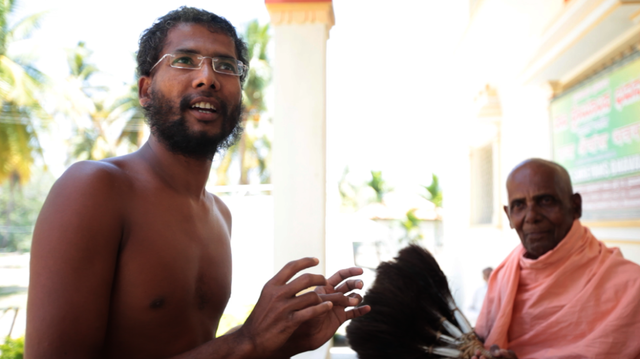The Ancient Roots of Jainism

Jainism and Buddhism are not offshoots or versions of Hinduism. They are not even protest movements or heretical groups that developed on the basis of opposing Hinduism. Both of them are the living versions of what in India was once famous as the sramana tradition.
To understand this, we must understand that the terms Hinduism, Buddhism and Jainism are reasonably contemporary, but the traditions they represent are multiple and their histories span thousands of years.
The many things that are Hinduism
Hinduism in particular has come to include all kinds of belief and practice systems, often from entirely different groups of people with different ethnic and social histories. These often meld into each other on the basis of shared concepts and the constant revisioning, reinterpretation and inclusive expansion of the Hindu literature and philosophy. The dominant voice of Hinduism, however, has often come from the brahminical tradition. The brahmins in particular are often viewed as a priestly class who were and still are considered by many as the custodians of the Vedic religion and the systems derived from it. This thread of faith is traced both traditionally and historically to the Vedas, which are considered the oldest Hindu texts. The Vedic people are thought to have slowly migrated into India over a long period from the north-west.
Over time, through a process of churning and assimilation of local cultures, there formed the currently recognizable mix of the six major branches of ‘orthodox’ Hindu philosophy and significantly different ideas. These include various kinds of Shaiva, Shakta and other forms of god and goddess worship, animistic beliefs and other systems of belief, faith and philosophical positions. Each category has an entire gamut of sects and subsects.
The sramanas
The term ‘sramana‘ comes from the word ‘sram‘ or ‘labour’, and means ‘someone who performs labour’. The term is thought to indicate someone who depends on their own hard work for attaining their spiritual goal. The sramanas represented a collection of thinkers, the common features amongst whom include the questioning of ideas about social order, divinity and the cosmos. All of them also had a focus on contemplative living and individual thought, speech and action in relation to a world with underlying principles. Sramana teachers are noted for their renunciation of Vedic society and the authority of the Vedas. Vedic commentators describe sramanas as ‘nastika’ or ‘non-believers’.

Sramanas were characterized by their groups of ascetics who lived and studied together as an order. The sramanas also had very austere lives with strict ethical codes for both ascetics as well lay followers. Most notably, all sramana schools were mostly non-theistic, or at best, had secondary and tertiary places for gods and cosmic beings. Early Buddhist literature identifies six sramana schools; new schools usually formed around charismatic teachers. Some of the sramana schools such as Buddhism were younger than what we may call Hinduism, but there may have been many older traditions.
Blurry beginnings
One of the sramana sects, in particular, has traditionally claimed a pre-Vedic, indigenous antiquity. The early Buddhists knew them as the nirgranthas and we know them as the Jains. During Buddha’s time, Mahavira was the teacher who championed the nirgrantha ascetics. Parsvanath, the nirgrantha teacher preceding Mahavira, is also considered historical, though the number of years that passed between Parsvanath and Mahavira is debated. Archaeological evidence for pre-Vedic sramanas in particular is bleak, but it is clear that the Indian subcontinent had several well-settled civilizations, tribes and communities with rich cultures well before the semi-nomadic, pastoral Vedic migrants began to move in.

The motifs in nirgrantha mythology also indicate an ancient past. The first teacher and spiritual leader of the community, Adinath or Rishabhdev, is thought to have taught people, amongst other things, the concepts of agriculture, animal husbandry, settlements, marriage and families. One may ignore the literal aspects of the mythology, but it indicates that the community may hark from a time when people were beginning to settle down. It is also interesting to note that while the mythological Adinath teaches people to settle down and the historical Mahavira teaches people to renounce society, there are connecting motifs between their teachings such as attention towards all aspects of nature, non-violence towards all beings and ethical rigour in all actions.
On the basis of the remarkable differences between the Vedic and the sramana philosophies, the presence of poorly-understood pre-Vedic cultures in general and various indications within mythology, many historians agree that the sramana tradition is indeed indigenous and pre-Vedic, though the exact origins and early history are not known and cannot be established from existing evidence.
Jainism today
Traditionally, the highest teachers of Jainism who attain liberation from the cycle of birth and death are thought to have conquered the world and their own selves, and are known as ‘jina’ or ‘victor’. The term ‘Jain’ comes from the word ‘jina’.
The current view of the Jain philosophy holds that there is no creator-god, the universe is uncreated, eternal and cyclical. All beings are dependent on each other, and have potentially divine souls who can attain liberation on the basis of the ethical quality of their own actions. Truth is thought to have multiple perspectives, and is thought to be only partially comprehensible to ordinary beings. The view of some kind of a singular truth or kevalgyan is thought to be restricted to liberated beings. The path to liberation is thought comprise of the right vision, the right knowledge and the right conduct. Conduct in the form of thought, speech and action is thought to have a real as well as spiritual outcome, measured by karma. A being is liberated when they are able to rid themselves of all karma.
The ethics for being a Jain are thought to be well-codified in the five precepts of ahinsa or non-violence, aparigraha or restrained consumption, asteya or non-stealing, satya or truth and brahmacharya or sexual restraint. Ethical instructions also go into specific details of thoughtful conduct, such as how to treat food or waste. The Jain thinkers also have their own categorization of beings in the world, from microorganisms to plants to animals and humans. Behaviours of and towards each category is also outlined. Meditative contemplation in general and towards all aspects of one’s life is emphasized for a fruitful pursuit of these ethics.

The culture and external trappings of contemporary Jain tradition incorporates many elements that the inner, ripened philosophy of it denounces. These include rituals, idol-worship, chants, temples, unquestioned obedience of scriptures and any form of symbolic or superstitious activity. As the Jain way of life spread and gained converts, it had to incorporate existing ways of the converted community by recasting them through a Jain worldview. For example, the Hindu epics of Ramayana and Mahabharata have Jain versions which take focus away from divine and semi-divine entities and try to depict the characters as human beings and posit the Jain ideals as the highest goals of life.
There are several sects and subsects of Jainism today, all of which share a majority of beliefs, including the innermost philosophies and ethical principles. The differences are over technical, mythological, historical, interpretive and other issues, none of which indicate a large departure from the fundamental basis of the Jain way of life. Once a major community, Jains today account for only a minuscule fraction of India’s population of more than 1.2 billion. Jainism is now recognized as a minority religion in India.
Reading list and notes:
[1] Lord Mahavira and His Times by Kailash Chand Jain, pp.129-141, pp. 152-356
[2] The Heathen in His Blindness: Asia, the West, and the Dynamic of Religion by S. N. Balagangadhara, pp. 228-238
[3] Buddhist Saints in India: A Study in Buddhist Values and Orientations, by Reginald A. Ray, pp. 65-68
[4] Sudras in Ancient India: A Social History of the Lower Order Down, by Ram Sharan Sharma, pp. 1-45, p. 147
[5] Way of Life: King, Householder, Renouncer: Essays in Honour of Louis Dumont by T. N. Madan, (Romila Thapar’s paper) pp. 273-297
[6] The Two Sources of Indian Asceticism by Johannes Bronkhorst, pp. 76-88
[7] Class and Religion in Ancient India by Jayantanuja Bandyopadhyaya, pp. 149-169
[8] Studies in the Origins of Buddhism by Govind Chandra Pande, pp. 250-368, pp. 540-566, pp. 541-574
[9] Karma and Rebirth in Classical Indian Traditions by Wendy Doniger, pp. 3-37
[10] The Origins of Yoga and Tantra: Indic Religions to the Thirteenth Century by Geoffrey Samuel, pp. 1-8
[11] The Ancient Indus Valley: New Perspectives by Jane McIntosh, Chapter 9
[12] Extracts from transliterations and translations of the Rig Veda
